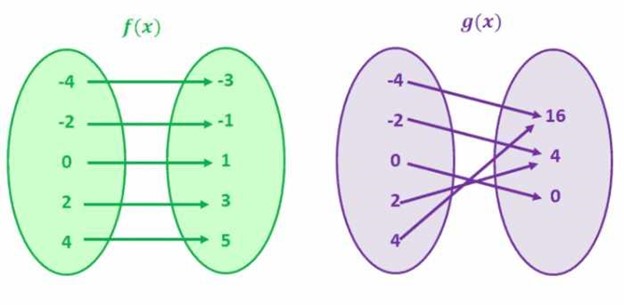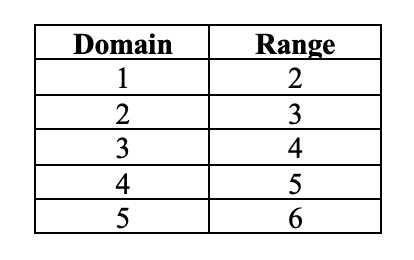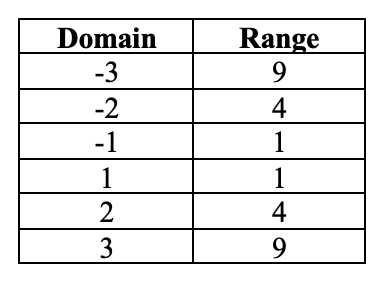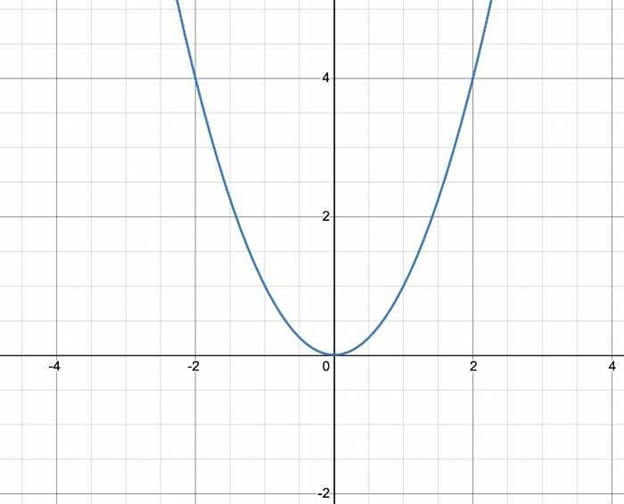One to One Functions - Graph, Examples | Horizontal Line Test
What is a One to One Function?
A one-to-one function is a mathematical function where each input correlates to a single output. In other words, for each x, there is a single y and vice versa. This implies that the graph of a one-to-one function will never intersect.
The input value in a one-to-one function is the domain of the function, and the output value is noted as the range of the function.
Let's look at the pictures below:

For f(x), every value in the left circle corresponds to a unique value in the right circle. Similarly, each value on the right corresponds to a unique value in the left circle. In mathematical terms, this implies every domain owns a unique range, and every range has a unique domain. Therefore, this is an example of a one-to-one function.
Here are some additional representations of one-to-one functions:
-
f(x) = x + 1
-
f(x) = 2x
Now let's look at the second example, which displays the values for g(x).
Notice that the inputs in the left circle (domain) do not own unique outputs in the right circle (range). Case in point, the inputs -2 and 2 have equal output, i.e., 4. In the same manner, the inputs -4 and 4 have identical output, i.e., 16. We can discern that there are identical Y values for many X values. Hence, this is not a one-to-one function.
Here are additional representations of non one-to-one functions:
-
f(x) = x^2
-
f(x)=(x+2)^2
What are the characteristics of One to One Functions?
One-to-one functions have the following qualities:
-
The function holds an inverse.
-
The graph of the function is a line that does not intersect itself.
-
They pass the horizontal line test.
-
The graph of a function and its inverse are equivalent with respect to the line y = x.
How to Graph a One to One Function
When trying to graph a one-to-one function, you are required to find the domain and range for the function. Let's look at an easy example of a function f(x) = x + 1.

Once you have the domain and the range for the function, you need to chart the domain values on the X-axis and range values on the Y-axis.
How can you determine whether a Function is One to One?
To indicate whether or not a function is one-to-one, we can apply the horizontal line test. Immediately after you chart the graph of a function, draw horizontal lines over the graph. If a horizontal line passes through the graph of the function at more than one place, then the function is not one-to-one.
Due to the fact that the graph of every linear function is a straight line, and a horizontal line doesn’t intersect the graph at more than one place, we can also deduct all linear functions are one-to-one functions. Keep in mind that we do not use the vertical line test for one-to-one functions.
Let's study the graph for f(x) = x + 1. Immediately after you chart the values for the x-coordinates and y-coordinates, you have to consider whether or not a horizontal line intersects the graph at more than one place. In this example, the graph does not intersect any horizontal line more than once. This indicates that the function is a one-to-one function.

On the contrary, if the function is not a one-to-one function, it will intersect the same horizontal line more than one time. Let's study the figure for the f(y) = y^2. Here are the domain and the range values for the function:

Here is the graph for the function:

In this example, the graph intersects multiple horizontal lines. For instance, for each domains -1 and 1, the range is 1. In the same manner, for either -2 and 2, the range is 4. This implies that f(x) = x^2 is not a one-to-one function.
What is the inverse of a One-to-One Function?
As a one-to-one function has a single input value for each output value, the inverse of a one-to-one function also happens to be a one-to-one function. The opposite of the function essentially undoes the function.
For example, in the example of f(x) = x + 1, we add 1 to each value of x in order to get the output, or y. The inverse of this function will remove 1 from each value of y.
The inverse of the function is denoted as f−1.
What are the characteristics of the inverse of a One to One Function?
The properties of an inverse one-to-one function are no different than all other one-to-one functions. This means that the reverse of a one-to-one function will possess one domain for each range and pass the horizontal line test.
How do you determine the inverse of a One-to-One Function?
Figuring out the inverse of a function is very easy. You simply have to change the x and y values. Case in point, the inverse of the function f(x) = x + 5 is f-1(x) = x - 5.

As we discussed earlier, the inverse of a one-to-one function undoes the function. Considering the original output value showed us we needed to add 5 to each input value, the new output value will require us to subtract 5 from each input value.
One to One Function Practice Examples
Contemplate the subsequent functions:
-
f(x) = x + 1
-
f(x) = 2x
-
f(x) = x2
-
f(x) = 3x - 2
-
f(x) = |x|
-
g(x) = 2x + 1
-
h(x) = x/2 - 1
-
j(x) = √x
-
k(x) = (x + 2)/(x - 2)
-
l(x) = 3√x
-
m(x) = 5 - x
For each of these functions:
1. Identify whether or not the function is one-to-one.
2. Chart the function and its inverse.
3. Figure out the inverse of the function algebraically.
4. Specify the domain and range of each function and its inverse.
5. Apply the inverse to determine the value for x in each calculation.
Grade Potential Can Help You Learn You Functions
If you happen to be having problems trying to understand one-to-one functions or similar concepts, Grade Potential can connect you with a one on one instructor who can support you. Our St Louis math tutors are skilled educators who help students just like you enhance their mastery of these concepts.
With Grade Potential, you can work at your individual pace from the convenience of your own home. Book a meeting with Grade Potential today by calling (314) 530-1892 to get informed about our educational services. One of our representatives will contact you to better determine your requirements to provide you with the best teacher for you!




